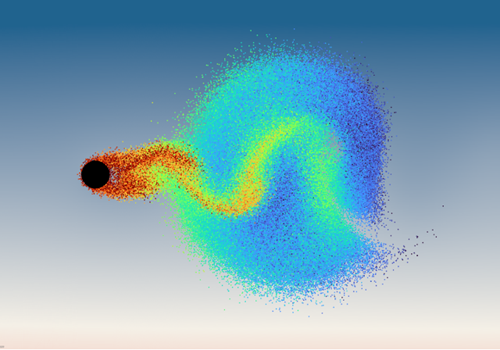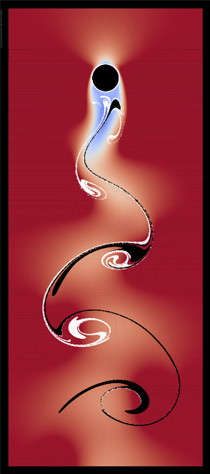Andrew Yeckel > Art Gallery
Art Gallery
Everything shown here is Copyright © 2020 Andrew Yeckel, all rights reserved
Where does the artwork come from?
I worked as a scientist for 30 years in computational physics and crystal growth. I left my career recently to focus on the creative side of my research. I spend most of my time developing and using software to simulate flow of liquids and gases and other physical processes observed in nature.
Visualization is the oldest method for investigating flow. Everyday examples abound. Smoke rings react to invisible air currents in a room. Clouds in the sky show the winds aloft. Minerals sparkling in a brook reveal its sinuous path below the surface. In the laboratory, flow is often visualized by injecting dye into a liquid, or by adding reflective particles such as aluminum dust or tiny glass beads to it. Many beautiful photographs obtained this way have been published in the scientific literature.
Sadly, the scientific community has shown little interest in creating aesthetically pleasing images from computer simulations of flowing liquids to compare to these experimental photographs. During my career I was frequently disappointed in the software tools commercially available for flow visualization. In response I have developed my own visualization software. I did this primarily to benefit my scientific research, but I soon realized I had opened up an aesthetic dimension that I am just beginning to appreciate.

There is an organic character to my art. Its creative roots extend below the surface into my computer code, both how it is written and how I use it to create my visualizations. The Newtonian physics underpinning my simulations is a bottomless well of beauty to draw upon. I serve as an explorer as much as I do an artist. In this way I am more like a photographer than a digital painter, seeking out the right place, angle and light to capture a beautiful moment in nature.
All of my artworks are generated from scrupulously accurate simulations of fluid dynamics and other physical phenomena. My professional website describes the software used to compute the simulations and make these images. Accuracy must be carefully preserved at every step of the process, else the images lose clarity, like a camera out of focus.
Vortex Street Collection
The Kármán vortex street is one of the most famous phenomena in fluid dynamics. Here it occurs in the wake of a stream flowing past a cylinder. These can be made in nearly any aspect ratio and they display well hung in any orientation.



These works embody artist Paul Klee's sentiment: A
drawing is simply a line going for a walk. I have many
images of this kind, each one
a unique creation.
One of my vortex street images appears on the front cover of
this journal published by the European Mathematical
Society.
Mondrian Collection
These images are generated by allowing a Mondrian-inspired painting to mix for varying lengths of time in a driven cavity flow with top and bottom boundaries moving in opposite directions. The "hourglass" pattern of mixing reveals a pair of co-rotating vortexes connected by a saddle streamline.
These look nice in groupings. Eight
variations are shown here, along with the original
reference image based on Mondrian's Large Composition in
Red, Blue, and Yellow.
I've written a short article that talks
about how I view these works in relation Mondrian's
progression from painting strongly figurative works such as
landscapes to the purely abstract linear forms that made him
famous.
Fandango Collection
The classic Spanish courtship dance is performed by a pair of co-rotating Lamb-Oseen vortexes.


These remind me of many things, and I've given them names like Rising Sun, Sea Creatures, and Kaleidoscope, but Fandango is what these images are really about. See more of them here.


